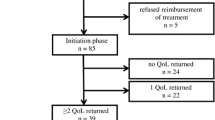Abstract
Background
Heart failure (HF) is a major problem in the long-term follow-up of adolescents and adults with congenital heart disease (ACHD) after cardiac surgery. The functional status of ACHD may be assessed in terms of the NYHA classification or the Ability index (ABILITY).
Objective
The purpose of our study was to examine which of the two classification systems is more closely related to objectively defined HF.
Methods
NT-pro brain natriuretic peptide (N-BNP) and maximal oxygen uptake (VO2max) were measured in 360 consecutive ACHD patients. HF was defined as an elevated N-BNP level ≥100 pg/ml combined with a reduced VO2max ≤25 ml/kg/min.
Results
There were no significant differences between the NYHA and ABILITY in grading HF in these patients. In both classifications, the risk of HF increases continuously over the classes and grades from odds ratio (OR) 1 in NYHA I/ABILITY 1 to an OR=3.4 in NYHA II/ ABILITY 2 up to 11.6 or 5.4 (ns) in NYHA III/ABILITY 3. Thus in the highest scores HF is found in 70–77% of the patients. The fact that in NYHA class I and ABILITY grade 1, 15% and 19% of the patients exhibited HF according to the measured indices underscores the discrepancy between subjective and objective assessment of the individual patients condition.
Conclusion
The NYHA classification and the Ability index take different approaches to the patients with congenital heart defects but are equally suitable for the judgement of HF in post surgical ACHD.
Similar content being viewed by others
References
Warnes CA, Somerville J (1986) Tricuspid atresia in adolescents and adults: current state and late complications. British Heart Journal 56:535– 543
Kamphuis RP, Ottenkamp J, Vliegen HW, Vogels T, Zwinderman KH, Kamphuis RP, Veroove-Vanhorick SP (2002) Health related quality of life and health status inadult survivors with previously operated complex congenital heart disease. Heart 7:356–332
Moons P, Van Deyk K, De Geest S, Gewillig M, Budts W (2005) Is the severity of congenital heart disease associated with the quality of life and perceived health of adult patients? Heart 91:1193–1198
Moons P, Van Deyk K, Budts W, De Geest S (2004) Caliber of quality-oflife assessments in congenital heart disease: a plea for more conceptual and methodological rigor. Archives of Pediatrics and Adolescent Medicine 158:1062–1069
Wilson NJ, Clarkson PM, Barratt- Boyes BG, Calder AL, Whitlock RM, Easthope RN, Neutze, JM (1998) Long-term outcome after the mustard repair for simple transposition of the great arteries. 28-year follow-up. J Am Coll Cardiol 32:758–765
Beauchesne LM, Warnes CA, Connolly HM, Ammash NM, Tajik AJ, Danielson GK (2002) Outcome of the unoperated adult who presents with congenitally corrected transposition of the great arteries. J Am Coll Cardiol 40:285–290
Norozi K, Wessel A, Alpers V, Arnhold JO, Geyer S, Zoege M, Buchhorn R (2006) Incidence and risk distribution of heart failure in adolescents and adults with congenital heart disease after cardiac surgery. Am J Cardiol 97:1238–1243
Scharhag J, Urhausen A, Herrmann M, Schneider G, Kramann B, Herrmann W, Kindermann W (2004) No difference in N-terminal pro-brain natriuretic peptide (NT-proBNP) concentrations between endurance athletes with athlete’s heart and healthy untrained controls. Heart 90:1055– 1056
Goetze JP, Kastrup J, Pedersen F, Rehfeld JF (2002) Quantification of pro-B-type natriuretic peptide and its products in human plasma by use of an analysis independent of precursor processing. Clin Chem 48:1035–1042
Mueller T, Gegenhuber A, Poelz W, Haltmayer M (2004) Head-to-head comparison of the diagnostic utility of BNP and NT-proBNP in symptomatic and asymptomatic structural heart disease. Clin Chim Acta 341:41–48
Swedberg K, Cleland J, Dargie H, Drexler H, Follath F, Komajda M, Tavazzi L, Smiseth OA, Gavazzi A, Haverich A, Hoes A, Jaarsma T, Korewicki J, Levy S, Linde C, Lopez-Sendon JL, Nieminen MS, Pierard L, Remme WJ (2005) Guidelines for the diagnosis and treatment of chronic heart failure: executive summary (update 2005). The Task Force for the Diagnosis and Treatment of Chronic Heart Failure of the European Society of Cardiology. Eur Heart J 26:1115–1140
Kruger S, Graf J, Kunz D, Stickel T, Hanrath P, Janssens U (2002) Brain natriuretic peptide levels predict functional capacity in patients with chronic heart failure. J Am Coll Cardiol 40:718–722
Moons P, De Bleser L, Budts W, Sluysmans T, DeWolf D, Massin M, Gewillig M, Pasquet A, Sluys B, Vliers A (2004) Health status, functional abilities, and quality of life after mustard or senning operation. The Annals of Thoracic Surgery 77:1359–1365
Bleumink GS, Knetsch AM, Sturkenboom MC, Straus SM, Hofman A, Deckers JW, Witteman JC, Stricker BH (2004) Quantifying the heart failure epidemic: prevalence, incidence rate, lifetime risk and prognosis of heart failure The Rotterdam Study. Eur Heart J 25:1614–1619
Levy D, Kenchaiah S, Larson MG, Benjamin EJ, Kupka MJ, Ho KK, Murabito JM, Vasan RS (2002) Longterm trends in the incidence of and survival with heart failure. N Engl J Med 347:1397–1402
Author information
Authors and Affiliations
Corresponding author
Additional information
*Both authors contributed equally to this work
Rights and permissions
About this article
Cite this article
Norozi*, K., Wessel*, A., Buchhorn, R. et al. Is the Ability index superior to the NYHA classification for assessing heart failure?. Clin Res Cardiol 96, 542–547 (2007). https://doi.org/10.1007/s00392-007-0530-z
Received:
Accepted:
Published:
Issue Date:
DOI: https://doi.org/10.1007/s00392-007-0530-z




